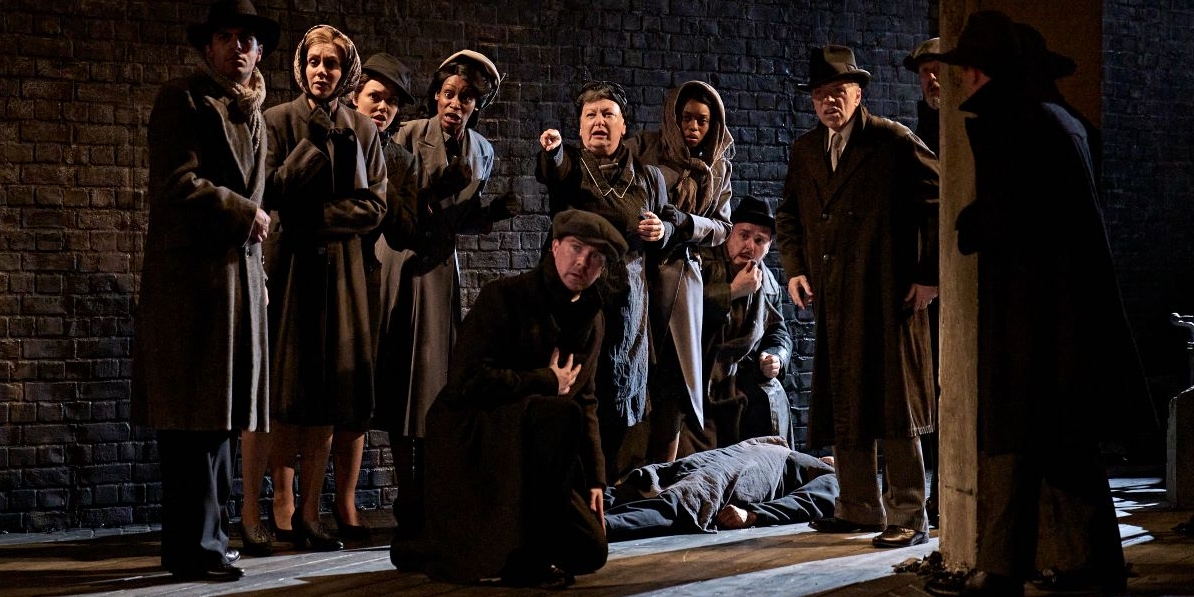Does every play, film or opera have the potential to become a musical? This is the question posed by the new adaptation of ‘The Third Man’ opening at the Menier Chocolate Factory. Many of the creatives involved are among the most garlanded figures in the recent history of musical theatre, and that ensures that the production values will be of the highest calibre. However, that only takes us so far – the key issue is whether there is anything meaningful to add to the film of 1949, which with its script by Graham Greene, direction by Carol Reed and expressionist camerawork and glittering cast, has claims to be one of the finest thrillers ever made.
Things begin well: Paul Farnsworth’s monochrome set, designed in the round, takes us right into the pinched, ruined, ambience of post-war occupied Vienna. Heaps of rubble, a marbled floor, many exits and entrances to evoke various buildings and – later – the famous sewers, all decked out with faded posters in German. Likewise the opening chorus – a slow-motion version of the famous zither theme from the film – introduces a cast of down-at-heel characters economically in a way that reminds you that Trevor Nunn was the first director of ‘Les Miserables.’
But thereafter much goes awry.
Once Holly Martins arrives in search of his friend Harry Lime, the exposition becomes clunky and heavy-handed, much more telling than showing. There is very little tension in either the dialogue, acting or music. The best efforts in that direction come from Gregory Clarke’s soundscape, which does produce evocative noises from every side of the theatre. However, overall the effects are simply dull: one scene of exposition succeeds another which yield more information but no frisson. The second half has a bit more drive but even the return of Sam Bailey as Harry Lime does not set the evening alight as it should. There is simply too much rushing around to generate action that in fact leaves little resonance. The dialogue and lyrics by Don Black and Christopher Hampton are serviceable, but rarely incisive or memorable.
And without the creation of compelling atmosphere there is really no need for musical commentary. It is crucial in a musical that you feel the transition from words to music to be inevitable. But the mostly bland numbers by George Fenton only add meaningfully to the show at two points – in illuminating and opening out the thoughts and feelings of Anna Schmidt, the heroine who remains enigmatic in the film, and in helping to establish the ambience of post-war Vienna. There are some good voices here, and the band, led by Tamara Saringer, is excellent, offering crisp ensemble and some delectable solos. But that is not enough.
Perhaps in an over-reaction to these issues, Sam Underwood plays Holly Martins in a state of perpetual near-lachrymose agitation. The portrayal does not develop as it should – as it does so memorably in the hands of Joseph Cotten in the film. Sam Bailey’s Harry echoes the suave and chilling portrayal by Orson Welles, but the key scene on the ferris wheel is underpowered, partly because placing the actors on a raised platform gives little impression of the reality of the location. Natalie Dunne does well in the role of Anna, making the most of the varied songs she is given, even though some of them seem to belong more to the world of ‘Cabaret’ than to this film. Among the supporting cast, Gary Milner stands out for his vocal prowess and through the character of ‘Baron Kurtz’, his evocation of the world of Old Vienna. It was good to see Derek Griffiths in the cast giving a vivid portrait of the Porter, who knows and says too much. There are no weak links in the cast, but the material does not always show them to best advantage.
This musical deserves three stars for the sake of its highly professional production, where direction, musical performance, lighting, sound, and acting by the leads and the company all operate to a high standard. But, unfortunately, the concept of turning this classic film into a musical does not ultimately convince.

